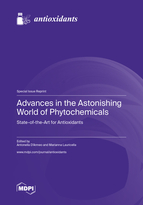Advances in the Astonishing World of Phytochemicals: State-of-the-Art for Antioxidants
A special issue of Antioxidants (ISSN 2076-3921). This special issue belongs to the section "Natural and Synthetic Antioxidants".
Deadline for manuscript submissions: closed (15 July 2023) | Viewed by 41010
Special Issue Editors
Interests: biochemical pathways in cancer cell death (apoptosis, necrosis, necroptosis, autophagy and anoikis); nutrition and human diseases; oxidative stress; signal transduction; targeted therapies; cancer stem-like cells; analysis of the behaviours of phytocompounds in obesity treatment
Special Issues, Collections and Topics in MDPI journals
Interests: mechanisms of oxidative stress induction and main antioxidant systems; biochemical pathways of cell death and survival (apoptosis, necrosis, autophagy) in tumor cells; effects of phytocompounds in obesity reduction
Special Issues, Collections and Topics in MDPI journals
Special Issue Information
Dear Colleagues,
Several studies have shown that plants are a source of a plethora of bioactive compounds, such as phytohormones, glycosides, terpenoids, alkaloids, phenolic compounds, and essential oils, with a strong potential impact in the fields of pharmaceutics and agriculture. These phytochemicals represent a valuable weapon that plants use in self-defense to counteract the abiotic stress disturbing the delicate equilibrium between the generation of reactive oxygen species (ROS) and antioxidant defense systems.
In recent years, interest in this area of research has been increasing due to the multifaceted properties of natural compounds with antioxidants having anticancer, anti-inflammatory, and antimicrobial activity. Therefore, understanding the underlying mechanism of their action is crucial to establishing their real potential in applied sciences.
We invite investigators to propose reviews or original research articles concerning the most recent advances in the study of antioxidant molecular mechanisms able to be activated by plant-derived phytochemicals, with potential pharmacological and agricultural applications.
Potential topics include, but are not limited to:
- Antioxidant properties;
- Antioxidant mechanisms of action;
- Antioxidant and anticancer action;
- Antioxidant and antimicrobial properties;
- Antioxidant and anti-inflammatory action.
Please note that in studies of complex mixtures of natural products, the characterization of chemicals using analytical methodologies, such as HPLC, MS, LC–MS, HPLC–MS, and NMR, should be included.
Dr. Antonella D'Anneo
Dr. Marianna Lauricella
Guest Editors
Manuscript Submission Information
Manuscripts should be submitted online at www.mdpi.com by registering and logging in to this website. Once you are registered, click here to go to the submission form. Manuscripts can be submitted until the deadline. All submissions that pass pre-check are peer-reviewed. Accepted papers will be published continuously in the journal (as soon as accepted) and will be listed together on the special issue website. Research articles, review articles as well as short communications are invited. For planned papers, a title and short abstract (about 100 words) can be sent to the Editorial Office for announcement on this website.
Submitted manuscripts should not have been published previously, nor be under consideration for publication elsewhere (except conference proceedings papers). All manuscripts are thoroughly refereed through a single-blind peer-review process. A guide for authors and other relevant information for submission of manuscripts is available on the Instructions for Authors page. Antioxidants is an international peer-reviewed open access monthly journal published by MDPI.
Please visit the Instructions for Authors page before submitting a manuscript. The Article Processing Charge (APC) for publication in this open access journal is 2900 CHF (Swiss Francs). Submitted papers should be well formatted and use good English. Authors may use MDPI's English editing service prior to publication or during author revisions.
Keywords
- bioactive compounds
- phytochemicals
- antioxidant properties
- oxidative and nitrosative stress
- anticancer action
- antimicrobial properties
- anti-inflammatory actions








